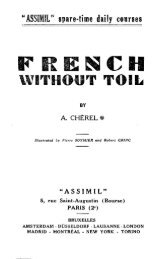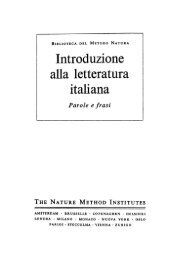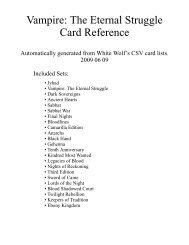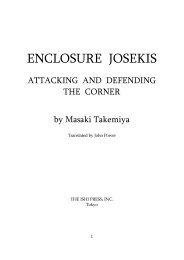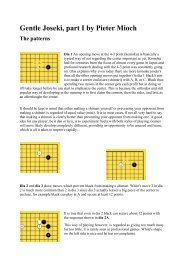Plains Cree: A Grammatical Study - Computer Science Club
Plains Cree: A Grammatical Study - Computer Science Club
Plains Cree: A Grammatical Study - Computer Science Club
You also want an ePaper? Increase the reach of your titles
YUMPU automatically turns print PDFs into web optimized ePapers that Google loves.
26 [TRANS. AMER. PHIL. SOC.<br />
sized here: from a <strong>Cree</strong> point of view the voice of<br />
English glosses is absolutely irrelevant. Whether<br />
sentence (4) is glossed 'The dog scares us' or 'We are<br />
scared by the dog' has no bearing on the meaning of<br />
the <strong>Cree</strong> sentence.7<br />
2.512. The use of "actor" and "goal" rather than<br />
"subject" and "object" is an extension of Bloomfield's<br />
usage which has become relatively standard for<br />
Algonquian linguistics.38<br />
The traditional use of the terms "subject" and<br />
"object" is based on Indoeuropean languages where<br />
the subject does not necessarily coincide with the<br />
actor; for example, in the Latin sentence,<br />
canis terretur d puero.<br />
'The dog is scared by the boy.'<br />
the goal canis is regarded as the subject by virtue of<br />
its case, agreement with the verb, etc. If "subject"<br />
and "object" were to be used in Algonquian, their<br />
general function would correlate much more closely<br />
with focus than with direction. In sentence (6),<br />
above, for example, while ndpew is the goal, it is<br />
proximate and therefore in focus and might well be<br />
labeled the "subject."<br />
Like many similar issues, however, this use of<br />
"subject" and "object" is held in abeyance until<br />
further semantic and syntactic studies indicate a<br />
clear need for these terms.<br />
2.52. Further Implications<br />
Among the implications of the direction contrast<br />
which remain to be explored more fully, indefinite<br />
actor forms constitute the most obvious problem.<br />
Morphologically, the indefinite actor forms of the<br />
transitive animate (TA) paradigm cannot be grouped<br />
with either the direct or the inverse set. The indf-3<br />
form of the independent order, e.g., wdpamaw 'he is<br />
seen,' shows the same morphological structure as the<br />
direct forms, notably the direction marker /a/.<br />
WOLFART: PLAINS CREE<br />
But<br />
all forms whose goal is a non-third person follow a<br />
different pattern (5.84). They are based on a suffix<br />
/ekawi/ whose connection with the inverse marker<br />
/ekw/ (cf. 5.422) remains to be clarified; e.g.,<br />
e-wapamikawiyan 'I am seen.'<br />
The inanimate actor set of the transitive animate<br />
(TA) paradigm (cf. 5.83) are based on the suffix<br />
/ekw/ and its extended form /eko/ and clearly belong<br />
to the inverse set, e.g., nipikiskwdtikon 'it talks to me.'<br />
37 Whatever stylistic carry-over might be found in translation<br />
would have to be restricted to third-person forms: if it were found<br />
that <strong>Cree</strong> speakers consistently prefer the English passive in trans-<br />
lating sentences like (6), this would lend added weight to the<br />
hypothesized similarity in function of English voice and <strong>Cree</strong><br />
focus.<br />
38 Of course, the choice of terms is primarily a matter of conven-<br />
tion and Bloomfield indicates as much when he says: "We prefer<br />
'actor' to the term 'subject' which might be misleading ..."<br />
(1962: p. 45).<br />
The semantic status of the indefinite actor forms<br />
is difficult to define in terms of the direction category.<br />
The examples given above can be described as actor-<br />
less verbs which only have a goal; in this they are<br />
somewhat similar to the agent-less passive of the<br />
Indoeuropean languages, e.g., Latin canis videtur 'the<br />
dog is seen.' But this interpretation is hardly<br />
appropriate for the transitive inanimate (TI) and<br />
animate intransitive (AI) forms, neither of which<br />
shows a goal:<br />
T73p18 k-etamihk TI<br />
'thus one calls it, thus it is called'<br />
T121-2 kzwdniwiw AI<br />
'there was going home, one went home.'<br />
Finally, there are a number of derivational types,<br />
many of them involving an /ek/-based suffix, whose<br />
meanings have been variously described as "middle"<br />
or "passive"; cf. 6.439 and the example quoted from<br />
Bloomfield in 2.53, below. The analysis of such<br />
formations would go far beyond the scope of the<br />
present discussion; for a detailed treatment in<br />
Menomini see Bloomfield 1962: pp. 280-298. A few<br />
examples from <strong>Cree</strong> follow: kisisow 'he is cooked to<br />
completion,' cf. klsiswew 'he cooks him to completion';<br />
kitimakeyimow 'he feels pitiable,' cf. kitimdkeyimew 'he<br />
takes pity on him'; kipahikdsow 'he is obstructed,' cf.<br />
kipaham 'he closes, obstructs it'; T102p6 .. . .miy-<br />
weyihtamwak, miyweyihcikdtew . . . 'they are glad, it<br />
feels good . . '; etc.<br />
2.53. Historical Survey<br />
In view of the remarkable confusion which has<br />
come to surround the term "passive" in Algonquian<br />
linguistics, it may be of interest to briefly review some<br />
of the uses to which it has been put. In so doing,<br />
we will also sketch the history of the voice interpre-<br />
tation of the direction category.<br />
Howse uses the term "passive" (1) of the various<br />
derivational patterns which were hinted at above; (2)<br />
of the indefinite actor forms which he also calls<br />
"indeterminate subjective" (1844: p. 107); and (3)<br />
of some manifestations of the direct-inverse contrast.<br />
In one context (1844: p. 57) he uses "active-<br />
passive" as synonymous with "direct-inverse"; but<br />
elsewhere (1844: p. 255) he greatly emphasizes that<br />
the active-passive distinction applies to the "double<br />
third persons" only: "These in their direct and<br />
inverse significations are active and passive, . . ., the<br />
other combinations of the pronoun being all expressed<br />
actively."<br />
It is noteworthy that Howse also sees the direction<br />
contrast in the you-and-me forms (1844: pp. 219, 220).<br />
Lacombe (1874b) uses "passif" of the mixed forms,<br />
i.e., those involving both a third and a non-third<br />
person referent. The indefinite actor forms he calls



